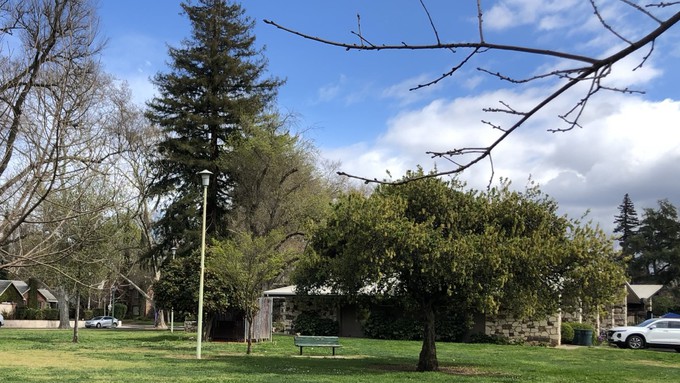
Clubs to offer their expertise, plants and wares; volunteers needed for McKinley Park beautification event

The Shepard Center is in the eastern extension of McKinley Park, which will gain some new trees Saturday. The center's big Spring Sale also happens this weekend. Admission is free. Kathy Morrison
This Saturday and Sunday, March 16 and 17, the garden and arts center in East Sacramento hosts its annual Spring Sale, featuring the two dozen-plus clubs that call Shepard home.
Shop for plants, flowers, crafts, jewelry, books, garden art and more at this huge event. Bring your dull knives and garden tools for sharpening (for a small donation).
This event is also a great chance to learn more about local garden and crafts clubs that meet at Shepard Center as well as get some expert advice. (See the list of clubs here.)
Sale hours are 10 a.m to 4 p.m. Saturday, 10 a.m. to 3 p.m. Sunday. Admission and parking are free.
Shepard Center is located at 3330 McKinley Blvd., Sacramento. For details and directions: https://www.sgaac.org/.
Also happening Saturday, March 16, is a volunteer opportunity that will have a lasting impact on McKinley Park, site of the center. Shepard Center is collaborating with the city’s Parks Department, the Sacramento Tree Foundation and SMUD to plant new trees in McKinley Park. These trees are replacements for some of those heavily damaged during last winter’s storms.
Saturday is the second part of a two-day planting spree at McKinley Park. Earlier this year, 30 volunteers representing several of Shepard’s clubs planted 13 new trees. City park staff dug the holes, then volunteers planted the trees and spread mulch rings around their planting sites. That’s also the plan for this second tree-planting event.
Chosen with the help of SacTree arborists, the new trees include ginkgo, cypress and tupelo varieties.
Saturday’s tree planting starts with a volunteer orientation at 9 a.m. at Clunie Memorial, at the western edge of McKinley Park, Alhambra Boulevard and F Street. Bring gloves and wear sturdy, closed-toe shoes.
Want to volunteer? Email Will Green at WGreen@surewest.net to RSVP.
Comments
0 comments have been posted.Sacramento Digs Gardening to your inbox.
Sites We Like
Garden Checklist for week of July 21
Your garden needs you!
* Keep your vegetable garden watered, mulched and weeded. Water before 8 a.m. to reduce the chance of fungal infection and to conserve moisture.
* Feed vegetable plants bone meal, rock phosphate or other fertilizers high in phosphate to stimulate more blooms and fruiting. (But wait until daily high temperatures drop out of the 100s.)
* Don’t let tomatoes wilt or dry out completely. Give tomatoes a deep watering two to three times a week.
* Harvest vegetables promptly to encourage plants to produce more. Squash especially tends to grow rapidly in hot weather. Keep an eye on zucchini.
* Pinch back chrysanthemums for bushy plants and more flowers in September.
* Remove spent flowers from roses, daylilies and other bloomers as they finish flowering.
* Pinch off blooms from basil so the plant will grow more leaves.
* Cut back lavender after flowering to promote a second bloom.
* It's not too late to add a splash of color. Plant petunias, snapdragons, zinnias and marigolds.
* From seed, plant corn, pumpkins, radishes, winter squash and sunflowers.